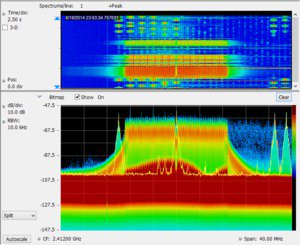
お問い合わせ
ダウンロード
マニュアル、データシート、ソフトウェアなどのダウンロード:
フィードバック
RSA306 USB Real Time Spectrum Analyzer Datasheet
RSA306 Datasheet. (RSA306 has been replaced by RSA306B)
このデータ・シートの製品は、テクトロニクスでは販売終了となっています。
Tektronix Encoreプレミアム再生品を見るbr/>
上記製品のサポートと保証のステータスをチェックする
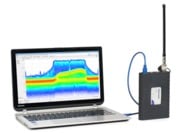
Replaced by: RSA306B USB Spectrum Analyzer
*
The RSA306 uses your PC and Tektronix SignalVu-PC™ RF Signal Analysis Software to provide real time spectrum analysis, streaming capture and deep signal analysis capabilities for signals from 9 kHz to 6.2 GHz, all in a low-cost, highly portable package that is ideal for field, factory, or academic use.
Key performance specifications
- 9 kHz to 6.2 GHz frequency range covers a broad range of analysis needs
- +20 dBm to -160 dBm measurement range
- Captures interference to ensure that you see problems first time, every time
- Mil-Std 28800 Class 2 environmental, shock and vibration specifications for use in harsh conditions
Key features
- Full-featured spectrum analysis capability with included Tektronix SignalVu-PC™ software
- 27 spectrum and signal analysis measurements standard
- Options for mapping, modulation analysis, WLAN and Bluetooth standards support, pulse measurements, playback of recorded files, and frequency settling
- Real time Spectrum/Spectrogram display to minimize time spent on transient and interference hunting
- Application programming interface (API) included for Microsoft Windows environments
- MATLAB instrument driver for use with Instrument Control Toolbox
- Streaming capture records long-term events
Applications
- Academic/education
- Maintenance, installation and repair in the factory or field
- Value-conscious design and manufacturing
- Interference hunting
The RSA306: a new class of instrument
The RSA306 offers full-featured spectrum analysis and deep signal analysis at a price unmatched by any previous offering. Using the latest in commercial interfaces and available computing power, the RSA306 separates signal acquisition from measurement, dramatically lowering the cost of instrument hardware. Data analysis, storage and replay is performed on your personal computer, tablet or laptop. Managing the PC separately from the acquisition hardware makes processing upgrades easy, and minimizes IT management issues.
SignalVu-PC™ software and an API for deep analysis and fast programmatic interaction
The RSA306 operates with SignalVu-PC, a powerful program that is the basis of Tektronix performance signal analyzers. SignalVu-PC offers a deep analysis capability previously unavailable in value-priced solutions. Real-time processing of the DPX spectrum/spectrogram is enabled in your PC, further reducing the cost of hardware. Customers who need programmatic access to the instrument can choose either the SignalVu-PC programmatic interface or use the included application programming interface (API) that provides a rich set of commands and measurements. A MATLAB driver for the API is available, enabling operation with MATLAB and the Instrument Control Toolbox.
Measurements included in SignalVu-PC base version
Basic functionality of the free SignalVu-PC program is far from basic. The table below summarizes the measurements included in the free SignalVu-PC software.
| General signal analysis | |
| Spectrum analyzer | Spans from 1 kHz to 6.2 GHz Three traces plus math and spectrogram trace Five markers with power, relative power, integrated power, power density and dBc/Hz functions |
| DPX Spectrum/Spectrogram | Real time display of spectrum with 100% probability of intercept of 100 μsec signals in up to 40 MHz span |
| Amplitude, frequency, phase vs. time, RF I and Q vs. time | Basic vector analysis functions |
| Time Overview/Navigator | Enables easy setting of acquisition and analysis times for deep analysis in multiple domains |
| Spectrogram | Analyze and re-analyze your signal with a 2-D or 3-D waterfall display |
| AM/FM listening | Hear, and record to file, FM and AM signals |
| Analog modulation analysis | |
| AM, FM, PM analysis | Measures key AM, FM, PM parameters |
| RF measurements | |
| Spurious measurement | User-defined limit lines and regions provide automatic spectrum violation testing across the entire range of the instrument |
| Spectrum emission mask | User-defined or standards-specific masks |
| Occupied Bandwidth | Measures 99% power, -xdB down points |
| Channel Power and ACLR | Variable channel and adjacent/alternate channel parameters |
| MCPR | Sophisticated, flexible multi-channel power measurements |
| CCDF | Complementary Cumulative Distribution Function plots the statistical variations in signal level |
The RSA306 with SignalVu-PC offers basic and advanced measurements for field and lab
See what you've never seen before: The 40 MHz real time bandwidth of the RSA306 combined with the processing power of SignalVu-PC shows you every signal, even down to 100 μs in duration. The following image shows a WLAN transmission (green and orange), and the narrow signals that repeat across the screen are a Bluetooth access probe. The spectrogram (upper part of the screen) clearly separates these signals in time to show any signal collisions.

Monitoring has never been easier. Spectrum mask testing captures detail of transients found in the frequency domain, such as intermittent interference. Mask testing can be set to stop acquisition, save acquisition, save a picture, and send an audible alert. The following image shows a spectrum mask (in orange on the spectrum display) created to monitor a band of frequencies for violations. A single transient of 125 μs duration has occurred that violated the mask, with the violation shown in red. The transient is clearly seen on the spectrogram above the red violation area (circled).
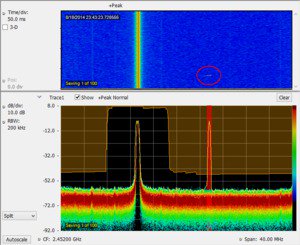
EMI pre-compliance and diagnostic measurements are easy with the RSA306 and SignalVu-PC. Transducer, antenna, preamplifier, and cable gain/loss can be entered and stored in correction files, and the standard spurious measurement feature of SignalVu-PC can be used to establish limit lines for your test. The following illustration shows a test from 400 MHz to 1 GHz with the test limit shown in green. Violations are recorded in the results table of the test below the graph, and the control panel for external loss entry is shown. CISPR peak detection and -6 dB filter bandwidths are standard functions, giving you comparable results to other tools.
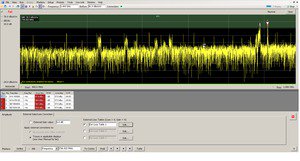
Analysis of AM and FM signals is standard in SignalVu-PC. The following screen shot shows a 1 kHz tone amplitude modulating a carrier to 48.9% total AM. Markers are used on the spectrum display to measure the modulation sideband at 1 kHz offset, 12.28 dB down from the carrier. The same signal is simultaneously viewed in the modulation display, showing AM versus time, with +Peak, -Peak and Total AM measurements. Advanced measurements for analog audio modulation including SINAD, THD and modulation rate are available in Option SVA.
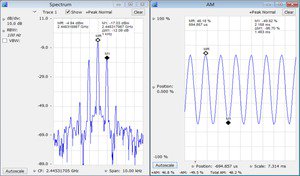
SignalVu-PC application-specific licenses
SignalVu-PC offers a wealth of application-oriented measurement and analysis options including:
- General-purpose modulation analysis (27 modulation types including 16/32/64/256 QAM, QPSK, O-QPSK, GMSK, FSK, APSK)
- P25 analysis of phase I and phase 2 signals
- WLAN analysis of 802.11a/b/g/j/p, 802.11n, 802.11ac
- LTE™ FDD and TDD Base Station (eNB) Cell ID & RF measurements
- Buetooth® analysis of Low Energy, Basic Rate and Enhanced Data Rate
- Mapping and signal strength
- Pulse analysis
- AM/FM/PM/Direct Audio Measurement including SINAD, THD
- Playback of recorded files, including complete analysis in all domains
- Signal Classification and Survey
Modulation analysis application SVM enables multiple displays of modulation quality. The following screen shot shows the standard Channel Power/ACLR measurement combined with a constellation display and vector signal quality measurements on a QPSK signal.
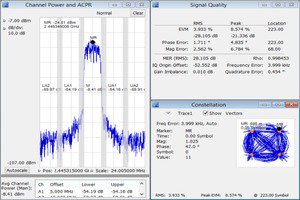
SignalVu-PC application SV26 enables quick, standards-based transmitter health checks on APCO P25 signals. The following image shows a Phase II signal being monitored for anomalies with the spectrum analyzer while performing transmitter power, modulation and frequency measurements.
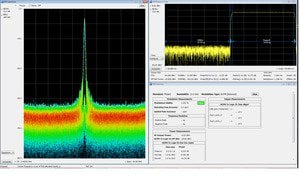
Sophisticated WLAN measurements are easy. On the following 802.11g signal display below, the spectrogram shows the initial pilot sequence followed by the main signal burst. The modulation is automatically detected as 64 QAM for the packet and displayed as a constellation. The data summary indicates an EVM of -33.24 dB RMS, and burst power is measured at 10.35 dBm. SignalVu-PC applications are available for 802.11a/b/j/g/p, 802.11n and 802.11ac to 40 MHz bandwidth.
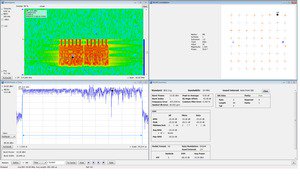
With application SV27 you can perform Bluetooth SIG standard-based transmitter RF measurements in the time, frequency, and modulation domains. This application supports Basic Rate and Low Energy Transmitter measurements defined by Bluetooth SIG Test Specification RF.TS.4.1.1 for Basic Rate and RF-PHY.TS.4.1.1 for Bluetooth Low Energy. Application SV27 also automatically detects Enhanced Data Rate packets, demodulates them and provides symbol information. Data packet fields are color encoded in the Symbol table for clear identification.
Pass/Fail results are provided with customizable limits and the Bluetooth presets make the different test set-ups push-button. The measurement below shows deviation vs. time, frequency offset and drift, and a measurement summary with pass/fail results.
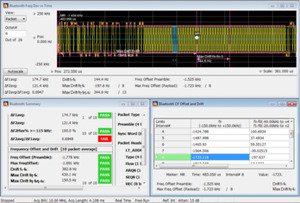
The SignalVu-PC MAP application enables interference hunting and location analysis. Locate interference with an azimuth function that lets you draw a line or an arrow on a mapped measurement to indicate the direction your antenna was pointing when you take a measurement. You can also create and display measurement labels.
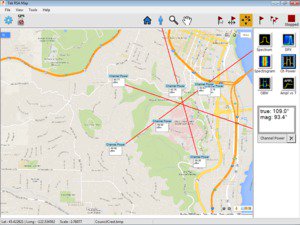
Application SV28 enables the following LTE base station transmitter measurements:
Cell ID
Channel Power
Occupied Bandwidth
Adjacent Channel Leakage Ratio (ACLR)
Spectrum Emission Mask (SEM)
Transmitter Off Power for TDD
There are four presets to accelerate pre-compliance testing and determine the Cell ID. These presets are defined as Cell ID, ACLR, SEM, Channel Power and TDD Toff Power. The measurements follow the definition in 3GPP TS Version 12.5 and support all base station categories, including picocells and femtocells. Pass/Fail information is reported and all channel bandwidths are supported.
The Cell ID preset displays the Primary Synchronization Signal (PSS) and the Secondary Synchronization Signal (SSS) in a Constellation diagram. It also provides Frequency Error.
The ACLR preset measures the E-UTRA and the UTRA adjacent channels, with different chip rates for UTRA. ACLR also supports Noise Correction based on the noise measured when there is no input. Both ACLR and SEM will operate in swept mode (default) or in faster single acquisition (real-time) when the measurement bandwidth required is less than 40 MHz.
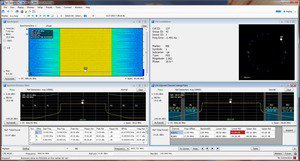
Playback of recorded signals can reduce hours of watching and waiting for a spectral violation to minutes at your desk reviewing recorded data. Recording length is limited only by storage media size and recording is a basic feature included in SignalVu-PC. SignalVu-PC application SV56 Playback allows for complete analysis by all SignalVu-PC measurements, including DPX Spectrogram. Minimum signal duration specifications are maintained during playback. AM/FM audio demodulation can be performed. Variable span, resolution bandwidth, analysis length, and bandwidth are all available. Frequency mask testing can be performed on recorded signals up to 40 MHz in span, with actions on mask violation including beep, stop, save trace, save picture, and save data. Portions of the playback can be selected and looped for repeat examination of signals of interest. Playback can be skip-free, or time gaps can be inserted to reduce review time. A Live Rate playback ensures fidelity of AM/FM demodulation and provides a 1:1 playback vs. actual time. Clock time of the recording is displayed in the spectrogram markers for correlation to real world events. In the illustration below, the FM band is being replayed, with a mask applied to detect spectral violations, simultaneous with listening to the FM signal at the center frequency of 92.3 MHz.
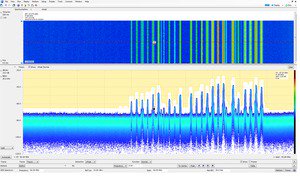
The signal classification application (SV54) enables expert systems guidance to aid the user in classifying signals. It provides graphical tools that allow you to quickly create a spectral region of interest, enabling you to classify and sort signals efficiently. The spectral profile mask, when overlaid on top of a trace, provides signal shape guidance, while frequency, bandwidth, channel number, and location are displayed allowing for quick checks. WLAN, GSM, W-CDMA, CDMA, Bluetooth standard and enhanced data rate, LTE FDD and TDD, and ATSC signals can be quickly and simply classified. Databases can be imported from your H500/RSA2500 signal database library for easy transition to the new software base.
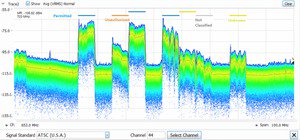
Above is a typical signal survey. This survey is of a portion of the TV broadcast band, and 7 regions have been declared as either Permitted, Unknown, or Unauthorized, as indicated by the color bars for each region.
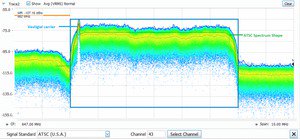
In this illustration, a single region has been selected. Since we have declared this to be an ATSC video signal, the spectrum mask for the ATSC signal is shown overlaid in the region. The signal is a close match to the spectrum mask, including the vestigial carrier at the lower side of the signal, characteristic of ATSC broadcasts.
SignalVu-PC with mapping can be used to manually indicate the azimuth of a measurement made in the field, greatly aiding in triangulation efforts. The addition of a smart antenna able to report its direction to SignalVu-PC automates this process. Automatically plotting the azimuth/bearing of a measurement during interference hunting can greatly speed the time spent searching for the source of interference. Tektronix offers the Alaris DF-A0047 handheld direction finding antenna with frequency coverage from 20 MHz -8.5 GHz (optional 9 kHz-20 MHz) as part of a complete interference hunting solution. Azimuth information and the selected measurement is automatically recorded on the SignalVu-PC Map just by releasing the control button on the antenna. Full specifications for the DF-A0047 antenna are available in a separate antenna datasheet available on www.Tektronix.com.
Specifications
Specifications are valid within the following conditions:
- Operate the instrument in an environment that meets the temperature, altitude, and humidity characteristics listed in these specifications.
- Warm up time is 30 minutes after connecting to the PC and starting the SignalVu application.
All specifications are guaranteed unless noted otherwise. All specifications apply to all models unless noted otherwise.
Frequency
- RF input frequency range
- 9 kHz to 6.2 GHz
- Frequency reference accuracy
- Initial
- ±3 ppm + aging (18 °C to 28 °C ambient, after 20 minute warm up)
±25 ppm + aging (-10 °C to 55 °C ambient, after 20 minute warm up), typical
- Aging (typical)
- ±3 ppm (1st year), ±1 ppm/year thereafter
- External frequency reference input
- Input frequency range
- 10 MHz ±10 Hz
- Input level range
- -10 dBm to +10 dBm sinusoid
- Impedance
- 50 Ω
- Center frequency resolution
- Block IQ samples
- 1 Hz
- Streamed ADC samples
- 500 kHz
Amplitude
- RF input impedance
- 50 Ω
- RF input VSWR (typical)
- ≤ 1.8:1 (10 MHz to 6200 MHz, reference level ≥ +10 dBm)
- Maximum RF input level without damage
- DC voltage
- ±40 VDC
- Reference level ≥ –10 dBm
- +23 dBm (continuous or peak)
- Reference level < –10 dBm
- +15 dBm (continuous or peak)
- Maximum RF input operating level
- The maximum level at the RF input for which the instrument will meet its measurement specifications.
- Center frequency < 22 MHz (low-frequency path)
- +15 dBm
- Center frequency ≥22 MHz (RF path)
- +20 dBm
- Amplitude accuracy at all center frequencies
Center frequency Warranted (18 °C to 28 °C) Typical (95% confidence) (18 °C to 28 °C) Typical (-10 °C to 55 °C) 9 kHz - < 3 GHz ±2.0 dB ±1.25 dB ±3.0 dB ≥ 3 GHz - 6.2 GHz ±2.75 dB ±2.0 dB ±3.0 dB - Reference level +20 dBm to -30 dBm, alignment run prior to testing.
Applies to corrected IQ data, with signal to noise ratios > 40 dB.
Accuracy may degrade up to ±0.6 dB after storage at maximum storage temperature, recovers within 24 hours
Intermediate frequency and acquisition system
- IF bandwidth
- 40 MHz
- ADC sample rate and bit width
- 112 Ms/s, 14 bits
- Real-time IF acquisition data (uncorrected)
- 112 Ms/s, 16-bit integer real samples
40 MHz BW, 28 ±0.25 MHz Digital IF, uncorrected. Corrected values are stored with saved files
Block streaming data at an average rate of 224 MB/s
- Block baseband acquisition data (corrected)
- Maximum acquisition time
- 1 second
- Bandwidths
- ≤ 40 /( 2N) MHz, 0 Hz Digital IF, N ≥ 0
- Sample rates
- ≤ 56 / (2N) Msps, 32-bit float complex samples, N ≥ 0
- Channel amplitude flatness
- ±1.0 dB, 18 ⁰C to 28 ⁰C
±2.0 dB, -10 ⁰C to 55 ⁰C, typical
±3.0 dB, 22 MHz - 24 MHz, -10 ⁰C to 55 ⁰C, typical
Reference level +20 dBm to -30 dBm, alignment run before testing
Applies to corrected IQ data, with signal to noise ratios > 40 dB
Trigger
- Trigger/sync input
- Voltage range
- TTL, 0.0 V – 5.0 V
- Trigger level, positive-going threshold voltage
- 1.6 V minimum; 2.1 V maximum
- Trigger level, negative-going threshold voltage
- 1.0 V minimum; 1.35 V maximum
- Impedance
- 10 kΩ
- IF power trigger
- Threshold range
- 0 dB to -50 dB from reference level, for trigger levels > 30 dB above the noise floor
- Type
- Rising or falling edge
- Trigger re-arm time
≤100 μs
Noise and distortion
- Displayed Average Noise Level (DANL)
- Reference level = -50 dBm, input terminated with 50 Ω load, log-average detection (10 averages). SignalVu-PC Spectrum measurements with Span > 40 MHz may use LF or RF path in the first segment of the spectrum sweep.
Center frequency Frequency range DANL (dBm/Hz) DANL (dBm/Hz), typical < 22 MHz (LF path) 100 kHz - 42 MHz -130 -133 ≥ 22 MHz (RF path) 2 MHz - 5 MHz -145 -148 > 5 MHz - 1.0 GHz -160 -163 > 1.0 GHz - 2.0 GHz -158 -161 > 2.0 GHz - 4.0 GHz -155 -158 > 4.0 GHz - 6.2 GHz -150 -153
- Phase noise
- Phase noise measured with 1 GHz CW signal at 0 dBm
The following table entries are in dBc/Hz units
Center frequency Offset 1 GHz 10 MHz (typical) 1 GHz (typical) 2.5 GHz (typical) 6 GHz (typical) 1 kHz -85 -115 -89 -78 -70 10 kHz -84 -122 -87 -84 -83 100 kHz -90 -126 -92 -92 -94 1 MHz -118 -127 -120 -114 -108
- Residual spurious response
- < -78 dBm (Reference level ≤ -50 dBm, RF input terminated with 50 Ω)
Harmonics of 112 MHz in the range 1680-2688 MHz
LO related spurious in the ranges 3895-3945 MHz, 4780-4810 MHz, and 4920-4950 MHz
- Input related spurious response (SFDR)
- ≤ -50 dBc, 18 ⁰C to 28 ⁰C, with auto settings on and signals 10 dB below reference level of -30 dBm, span ≤ 40 MHz
- Input frequencies ≤ 8 GHz
≤ -50 dBc, -10 ⁰C to 55 ⁰C, typical
Exceptions, typical:
IF feedthrough: ≤ -45 dBc for 1850 MHz - 2700 MHz center frequency
Image: ≤ -35 dBc for 3700 MHz - 3882 MHz center frequency; ≤ -35 dBc for 5400 MHz - 5700 MHz center frequency
RFx3LO: ≤ -45 dBc for 4175 MHz - 4225 MHz center frequency
- Input frequencies 6.2 GHz - 8.0 GHz, typical
- Image: ≤ -40 dBc for 3882 MHz - 4760 MHz center frequency
RFx2LO: ≤ -25 dBc for 4800 MHz - 5150 MHz center frequency
RFx3LO: ≤ -45 dBc for 4175 MHz - 4225 MHz center frequency
- Residual FM
- < 10 HzP-P (95% confidence)
- 3RD order IM distortion
- Two input CW signals, 1 MHz separation, each input signal level 5 dB below the reference level setting at the RF input
Reference level at-15 dBm disables Preamp; reference level at -30 dBm enables Preamp
- Center frequency 2130 MHz
- ≤ -60 dBc at reference level -15 dBm, 18 ⁰C to 28 ⁰C
≤ -60 dBc, at reference level -15 dBm, -10 ⁰C to 55 ⁰C, typical
- 40 MHz to 6.2 GHz, typical
- < -58 dBc at reference level = -10 dBm
< -50 dBc at reference level = -50 dBm
- 3RD order intercept (TOI)
- Center frequency 2130 MHz
- ≥ +10 dBm at reference level -15 dBm, 18 ⁰C to 28 ⁰C
≥ +10 dBm, at reference level -15 dBm, -10 ⁰C to 55 ⁰C, typical
- 40 MHz to 6.2 GHz, typical
- +14 dBm at reference level -10 dBm
-30 dBm at reference level -50 dBm
- 2ND harmonic distortion, typical
- < -55 dBc, 10 MHz to 300 MHz, reference level = 0 dBm
< -60 dBc, 300 MHz to 3.1 GHz, reference level = 0 dBm
< -50 dBc, 10 MHz to 3.1 GHz, reference level = -40 dBm
Exception: < -45 dBc in the range 1850-2330 MHz
- 2ND harmonic intercept (SHI)
- +55 dBm, 10 MHz to 300 MHz, reference level = 0 dBm
+60 dBm, 300 MHz to 3.1 GHz, reference level = 0 dBm
+10 dBm, 10 MHz to 3.1 GHz, reference level = -40 dBm
Exception: < +5 dBm in the range 1850-2330 MHz
- Local oscillator feedthrough to input connector
- < -75 dBm at reference level = -30 dBm
Audio Output
- Audio output (from SignalVu-PC or application programming interface)
- Types
- AM, FM
- IF bandwidth range
- Five selections, 8 kHz – 200 kHz
- Audio output frequency range
- 50 Hz – 10 kHz
- PC audio output
- 16 bits at 32 ks/s
- Audio file output format
- .wav format, 16 bit, 32 ks/s
SignalVu-PC base performance summary
Selected SignalVu-PC features when used with the RSA306. See the SignalVu-PC datasheet for more information on the application features.- SignalVu-PC/RSA306 key characteristics
- Maximum span
- 40 MHz real-time
9 kHz - 6.2 GHz swept
- Maximum acquisition time
- 1.0 s
- Minimum IQ resolution
- 17.9 ns (acquisition BW = 40 MHz)
- Tuning Tables
Tables that present frequency selection in the form of standards-based channels are available for the following.
Cellular standards families: AMPS, NADC, NMT-450, PDC, GSM, CDMA, CDMA-2000, 1xEV-DO WCDMA, TD-SCDMA, LTE, WiMax
Unlicensed short range: 802.11a/b/j/g/p/n/ac, Bluetooth
Cordless phone: DECT, PHS
Broadcast: AM, FM, ATSC, DVBT/H, NTSC
Mobile radio, pagers, other: GMRS/FRS, iDEN, FLEX, P25, PWT, SMR, WiMax
- Signal Strength display
- Signal strength indicator
- Located at right side of display
- Measurement bandwidth
- Up to 40 MHz, dependent on span and RBW setting
- Tone type
Variable frequency based on received signal strength
- Spectrum display
- Traces
- Three traces + 1 math trace + 1 trace from spectrogram for spectrum display
- Trace functions
- Normal, Average (VRMS), Max Hold, Min Hold, Average of Logs
- Detector
- Average (VRMS), Average, CISPR peak, +Peak, -Peak, Sample
- Spectrum trace length
- 801, 2401, 4001, 8001,10401, 16001, 32001, and 64001 points
- RBW range
- 10 Hz to 10 MHz
- DPX spectrum display
- Spectrum processing rate (RBW = auto, trace length 801)
- 10,000/s
- DPX bitmap resolution
- 201x801
- Marker information
- Amplitude, frequency, signal density
- Minimum signal duration for 100% probability of detection
- 100 μs
Span: 40 MHz, RBW = Auto, Max-hold on
Due to the non-deterministic execution time of programs running under the Microsoft Windows OS, this specification may not be met when the host PC is heavily loaded with other processing tasks
- Span range (continuous processing)
- 1 kHz to 40 MHz
- Span range (swept)
- Up to maximum frequency range of instrument
- Dwell time per step
- 50 ms to 100 s
- Trace processing
- Color-graded bitmap, +Peak, -Peak, average
- Trace length
- 801, 2401, 4001, 10401
- RBW range
- 1 kHz to 10 MHz
- DPX Spectrogram display
- Trace detection
- +Peak, -Peak, Average(VRMS)
- Trace length, memory depth
- 801 (60,000 traces)
2401 (20,000 traces)
4001 (12,000 traces)
- Time resolution per line
- 50 ms to 6400 s, user selectable
- Analog modulation analysis (standard)
- AM demodulation accuracy, typical
- ±2%
0 dBm input at center, carrier frequency 1 GHz, 1kHz/5kHz input/modulated frequency, 10% to 60% modulation depth
0 dBm input power level, reference level = 10 dBm
- FM demodulation accuracy, typical
- ±3%
0 dBm input at center, carrier frequency 1 GHz, 400Hz/1kHz input/modulated frequency
0 dBm input power level, reference level = 10 dBm
- PM demodulation accuracy, typical
- ±1% of measurement bandwidth
0 dBm input at center, carrier frequency 1 GHz, 1kHz/5kHz input/modulated frequency
0 dBm input power level, reference level = 10 dBm
SignalVu-PC application licenses
- AM/FM/PM and direct audio measurement (SVAxx-SVPC)
- Carrier frequency range (for modulation and audio measurements)
- (1/2 × audio analysis bandwidth) to maximum input frequency
- Maximum audio frequency span
- 10 MHz
- FM measurements (Mod. index >0.1)
- Carrier Power, Carrier Frequency Error, Audio Frequency, Deviation (+Peak, -Peak, Peak-Peak/2, RMS), SINAD, Modulation Distortion, S/N, Total Harmonic Distortion, Total Non-harmonic Distortion, Hum and Noise
- AM measurements
- Carrier Power, Audio Frequency, Modulation Depth (+Peak, -Peak, Peak-Peak/2, RMS), SINAD, Modulation Distortion, S/N, Total Harmonic Distortion, Total Non-harmonic Distortion, Hum and Noise
- PM measurements
- Carrier Power, Carrier Frequency Error, Audio Frequency, Deviation (+Peak, -Peak, Peak-Peak/2, RMS), SINAD, Modulation Distortion, S/N, Total Harmonic Distortion, Total Non-harmonic Distortion, Hum and Noise
- Direct audio measurements
- Signal power, Audio frequency (+Peak, -Peak, Peak-Peak/2, RMS), SINAD, Modulation distortion, S/N, Total harmonic distortion, Total non-harmonic distortion, Hum and Noise
- Audio filters
Low pass: 0.3, 3, 15, 30, 80, 300, and user-entered up to 0.9 × audio bandwidth
High pass: 20, 50, 300, 400, and user-entered up to 0.9 × audio bandwidth
Standard: CCITT, C-Message
De-emphasis (μs): 25, 50, 75, 750, and user-entered
File: User-supplied .TXT or .CSV file of amplitude/frequency pairs. Maximum 1000 pairs
Performance characteristics, typical Conditions: Unless otherwise stated, performance is given for: Modulation rate = 5 kHz
AM depth: 50%
PM deviation 0.628 Radians
FM AM PM Conditions Carrier Power accuracy Refer to instrument amplitude accuracy Carrier Frequency accuracy ± 7 Hz + (transmitter frequency × ref. freq. error) Refer to instrument frequency accuracy ± 2 Hz + (transmitter frequency × ref. freq. error) FM deviation: 5 kHz / 100 kHz Depth of Modulation accuracy NA ± 0.5% NA Rate: 5 kHz
Depth: 50%Deviation accuracy ± (2% × (rate + deviation)) NA ± 3% FM deviation: 100 kHz Rate accuracy ± 0.2 Hz ± 0.2 Hz ± 0.2 Hz FM deviation: 5 kHz / 100 kHz Residual THD 0.5% 0.5% NA FM Deviation: 5 kHz / 100 kHz
Rate: 1 kHzResidual SINAD 49 dB
40 dB56 dB 42 dB FM deviation 5 kHz
FM deviation 100 kHz
Rate: 1 kHz
- Pulse measurements (SVPxx-SVPC)
- Measurements (nominal)
- Average On Power, Peak Power, Average Transmitted Power, Pulse Width, Rise Time, Fall Time, Repetition Interval(seconds), Repetition Interval (Hz), Duty Factor (%), Duty Factor (ratio), Ripple, Droop, Pulse-Pulse Frequency Difference, Pulse-Pulse Phase Difference, RMS Frequency Error, Max Frequency Error, RMS Phase Error, Max Phase Error, Frequency Deviation, Phase Deviation, Time Stamp, Delta Frequency, Impulse Response, Overshoot
- Minimum pulse width for detection
- 150 ns
- Average ON power at 18 °C to 28 °C, typical
±1.0 dB + absolute amplitude accuracy
For pulses of 300 ns width or greater, duty cycles of .5 to .001, and S/N ratio ≥ 30 dB
- Duty factor, typical
- ±0.2% of reading
For pulses of 450 ns width or greater, duty cycles of .5 to .001, and S/N ratio ≥ 30 dB
- Average transmitted power, typical
±1.0 dB + absolute amplitude accuracy
For pulses of 300 ns width or greater, duty cycles of .5 to .001, and S/N ratio ≥ 30 dB
- Peak pulse power, typical
±1.5 dB + absolute amplitude accuracy
For pulses of 300 ns width or greater, duty cycles of .5 to .001, and S/N ratio ≥ 30 dB
- Pulse width, typical
±0.25% of reading
For pulses of 450 ns width or greater, duty cycles of .5 to .001, and S/N ratio ≥ 30 dB
- General purpose digital modulation analysis (SVMxx-SVPC)
- Modulation formats
- BPSK, QPSK, 8PSK, 16QAM, 32QAM, 64QAM, 128QAM, 256QAM, PI/2DBPSK, DQPSK, PI/4DQPSK, D8PSK, D16PSK, SBPSK, OQPSK, SOQPSK, 16-APSK, 32-APSK, MSK, GFSK, CPM, 2FSK, 4FSK, 8FSK, 16FSK, C4FM
- Analysis period
- Up to 81,000 samples
- Measurement filter
- Root Raised Cosine, Raised Cosine, Gaussian, Rectangular, IS-95 TX_MEA, IS-95 Base TXEQ_MEA, None
- Reference Filter
- Gaussian, Raised Cosine, Rectangular, IS-95 REF, None
- Filter rolloff factor
- α:0.001 to 1, in 0.001 steps
- Measurements
- Constellation, Demod I&Q vs. Time, Error Vector Magnitude (EVM) vs. Time, Eye Diagram, Frequency Deviation vs. Time, Magnitude Error vs. Time, Phase Error vs. Time, Signal Quality, Symbol Table, Trellis Diagram
- Symbol rate range
- 1 k symbols/s to 40 M symbols/s
Modulated signal must be contained entirely within the acquisition bandwidth
- Adaptive equalizer
- Linear, Decision-Directed, Feed-Forward (FIR) equalizer with coefficient adaptation and adjustable convergence rate. Supports modulation types BPSK, QPSK, OQPSK, π/2-DBPSK, π/4-DQPSK, 8-PSK, 8-DSPK, 16-DPSK, 16/32/64/128/256-QAM,16/32-APSK
- QPSK Residual EVM (center frequency = 2 GHz), typical
1.1 % (100 kHz symbol rate)
1.1 % (1 MHz symbol rate)
1.2 % (10 MHz symbol rate)
2.5 % (30 MHz symbol rate)
400 symbols measurement length, 20 Averages, normalization reference = maximum symbol magnitude
- 256 QAM Residual EVM (center frequency = 2 GHz), typical
0.8 % (10 MHz symbol rate)
1.5 % (30 MHz symbol rate)
400 symbols measurement length, 20 Averages, normalization reference = maximum symbol magnitude
- WLAN Measurements, 802.11a/b/g/j/p (SV23xx-SVPC)
- Measurements
- WLAN power vs. time; WLAN symbol table; WLAN constellation; spectrum emission mask; error vector magnitude (EVM) vs. symbol (or time), vs subcarrier (or frequency); mag error vs symbol (or time), vs. subcarrier (or frequency); phase error vs symbol (or time), vs. subcarrier (or frequency); channel frequency response vs. symbol (or time), vs. subcarrier (or frequency); spectral flatness vs. symbol (or time), vs. subcarrier (or frequency)
- Residual EVM - 802.11a/g/j /p (OFDM), 64-QAM, typical
2.4 GHz, 20 MHz BW: -38 dB
5.8 GHz, 20 MHz BW: -38 dB
Input signal level optimized for best EVM, average of 20 bursts, ≥16 symbols each
- Residual EVM - 802.11b, CCK-11, typical
2.4 GHz, 11 Mbps: 2.0 %
Input signal level optimized for best EVM, average of 1,000 chips, BT = .61
- WLAN Measurements 802.11n (SV24xx-SVPC)
- Measurements
- WLAN power vs. time; WLAN symbol table; WLAN constellation; spectrum emission mask; error vector magnitude (EVM) vs. symbol (or time), vs subcarrier (or frequency); mag error vs symbol (or time), vs. subcarrier (or frequency); phase error vs symbol (or time), vs. subcarrier (or frequency); channel frequency response vs. symbol (or time), vs. subcarrier (or frequency); spectral flatness vs. symbol (or time), vs. subcarrier (or frequency)
- EVM performance - 802.11n, 64-QAM, typical
2.4 GHz, 40 MHz BW: -35 dB
5.8 GHz, 40 MHz BW: -35 dB
Input signal level optimized for best EVM, average of 20 bursts, ≥16 symbols each
- WLAN Measurements 802.11ac (SV25xx-SVPC)
- Measurements
- WLAN power vs. time; WLAN symbol table; WLAN constellation; spectrum emission mask; error vector magnitude (EVM) vs. symbol (or time), vs subcarrier (or frequency); mag error vs symbol (or time), vs. subcarrier (or frequency); phase error vs symbol (or time), vs. subcarrier (or frequency); channel frequency response vs. symbol (or time), vs. subcarrier (or frequency); spectral flatness vs. symbol (or time), vs. subcarrier (or frequency)
- EVM performance - 802.11ac, 256-QAM, typical
5.8 GHz, 40 MHz BW : -35 dB
Input signal level optimized for best EVM, average of 20 bursts, ≥16 symbols each
- APCO P25 Measurements (SV26xx-SVPC)
- Measurements
- RF output power, operating frequency accuracy, modulation emission spectrum, unwanted emissions spurious, adjacent channel power ratio, frequency deviation, modulation fidelity, frequency error, eye diagram, symbol table, symbol rate accuracy, transmitter power and encoder attack time, transmitter throughput delay, frequency deviation vs. time, power vs. time, transient frequency behavior, HCPM transmitter logical channel peak adjacent channel power ratio, HCPM transmitter logical channel off slot power, HCPM transmitter logical channel power envelope, HCPM transmitter logical channel time alignment, cross-correlated markers
- Modulation fidelity, typical
C4FM = 1.3%
HCPM = 0.8%
HDQPSK = 2.5%
Input signal level is optimized for best modulation fidelity.
- Bluetooth Measurements (SV27xx-SVPC)
- Modulation formats
Basic Rate, Bluetooth Low Energy, Enhanced Data Rate - Revision 4.1.1
Packet types: DH1, DH3, DH5 (BR), Reference (LE)
- Measurements
- Peak Power, Average Power, Adjacent Channel Power or InBand Emission mask, -20dB Bandwidth, Frequency Error, Modulation Characteristics including ΔF1avg (11110000), ΔF2avg (10101010), ΔF2 > 115 kHz, ΔF2/ΔF1 ratio, frequency deviation vs. time with packet and octet level measurement information, Carrier Frequency f0, Frequency Offset (Preamble and Payload), Max Frequency Offset, Frequency Drift f1-f0, Max Drift Rate fn-f0 and fn-fn-5, Center Frequency Offset Table and Frequency Drift table, color-coded Symbol table, Packet header decoding information, eye diagram, constellation diagram
- Output power, In-band emissions and ACP
- Level uncertainty: refer to instrument amplitude and flatness specification
Measurement range: signal level > –70 dBm
- Modulation characteristics
Deviation range: ±280 kHz
Deviation uncertainty (at 0 dBm)
2 kHz + instrument frequency uncertainty (basic rate)
3 kHz + instrument frequency uncertainty (low energy)
Measurement range: Nominal channel frequency ±100 kHz
- Initial Carrier Frequency Tolerance (ICFT)
Measurement uncertainty (at 0 dBm): <1 kHz + instrument frequency uncertainty
Measurement range: Nominal channel frequency ±100 kHz
- Carrier Frequency Drift
Measurement uncertainty: <2 kHz + instrument frequency uncertainty
Measurement range: Nominal channel frequency ±100 kHz
- LTE Downlink RF measurements (SV28xx-SVPC)
- Standard Supported
3GPP TS 36.141 Version 12.5
- Frame Format supported
FDD and TDD
- Measurements and Displays Supported
- Adjacent Channel Leakage Ratio (ACLR), Spectrum Emission Mask (SEM), Channel Power, Occupied Bandwidth, Power vs. Time showing Transmitter OFF power for TDD signals and LTE constellation diagram for Primary Synchronization Signal, Secondary Synchronization Signal with Cell ID, Group ID, Sector ID and Frequency Error.
- ACLR with E-UTRA bands (Nominal, with Noise Correction)
1st Adjacent Channel 65 dB (RSA306)
2nd Adjacent Channel 66 dB (RSA306)
- Mapping (MAPxx-SVPC)
- Supported map types
- Pitney Bowes MapInfo (*.mif), Bitmap (*.bmp), Open Street Maps (.osm)
- Saved measurement results
- Measurement data files (exported results)
- Map file used for the measurements
- Google Earth KMZ file
- Recallable results files (trace and setup files)
- MapInfo-compatible MIF/MID files
- Playback of recorded signals (SV56xx-SVPC)
- Playback file type
- R3F recorded by RSA306
- Recorded file bandwidth
- 40 MHz
- File playback controls
- General: Play, stop, exit playback
Location: Begin/end points of playback settable from 0-100%
Skip: Defined skip size from 73 μs up to 99% of file size
Live rate: Plays back at 1:1 rate to recording time
Loop control: Play once, or loop continuously
- Memory requirement
- Recording of signals requires storage with write rates of 300 MB/sec. Playback of recorded files at live rates requires storage with read rates of 300 MB/sec.
Inputs, outputs, interfaces, power consumption
- RF input
- Type N, female
- External frequency reference input
- SMA, female
- Trigger/sync input
- SMA, female
- Status indicator
- LED, dual color red/green
- USB device port
- USB 3.0 - Micro-B
- Power consumption
- Per USB 3.0 SuperSpeed requirements: 5.0 V, ≤ 900 mA (nominal)
Physical characteristics
- Dimensions
- Height
- 30.5 mm (1.2 in)
- Width
- 190.5 mm (7.5 in)
- Depth
- 127 mm (5 in)
- Weight
- 0.59 kg (1.3 lbs)
Regulatory
- Safety
- UL61010-1, CAN/CSA-22.2 No.61010-1, EN61010-1, IEC61010-1
- Regional certifications
- Europe: EN61326
Australia/New Zealand: AS/NZS 2064
- EMC emissions
- EN61000-3-2, EN61000-3-3, EN61326-2-1
- EMC immunity
- EN61326–1/2, IEC61000-4-2/3/4/5/6/8/11
Environmental performance
- Temperature
- Operating
- -10 °C to +55 °C (+14 °F to +131 °F)
- Nonoperating
- -51 °C to +71 °C (-60 °F to +160 °F)
- Humidity (operating)
- 5% to 75% ±5% relative humidity (RH) from +30 °C to +40 °C (+86 °F to 104 °F)
5% to 45% RH above +40 °C to +55 °C (+86 °F to +131 °F)
- Altitude
- Operating
- Up to 9,144 meters (30,000 feet)
- Nonoperating
- 15,240 meters (50,000 feet)
- Dynamics
- Mechanical shock, operating
- Half-sine mechanical shocks, 30 g peak amplitude, 11 μs duration, three drops in each direction of each axis (18 total)
- Random vibration, nonoperating
- 0.030 g2/Hz, 10-500 Hz, 30 minutes per axis, three axes (90 minutes total)
- Handling and transit
- Bench handling, operating
- Per MIL-PRF-28800F Class 2 operating: Rotational-edge-drops of appropriate edges on appropriate sides of the equipment
- Transit drop, nonoperating
- Per MIL-PRF-28800F Class 2 nonoperating: Transit drops onto six faces and four corners of the equipment, from a height of 30 cm (11.8 in.) for a total of 10 impacts
Ordering information
Models
- RSA306
USB real time spectrum analyzer, 9 kHz - 6.2 GHz, 40 MHz acquisition bandwidth.
The RSA306 requires a PC with Windows 7 or Windows 8/8.1 or Windows 10, 64-bit operating system. A USB 3.0 connection is required for operation of the RSA306. 8 GB RAM and 20 GB free drive space is required for installation of SignalVu-PC. For full performance of the real time features of the RSA306, an Intel Core i7 4th generation processor is required. Processors of lower performance can be used, with reduced real-time performance.
Storage of streaming data requires that the PC be equipped with a drive capable of streaming storage rates of 300 MB/sec.
Standard accessories
- 174-6796-xx
- USB 3.0 locking cable (1 M)
- 063-4543-xx
- SignalVu-PC software, documentation, USB key
- 071-3323-xx
- Printed safety/installation manual (English)
Warranty
- Warranty
- 1 year
SignalVu-PC application-specific licenses
SignalVu-PC-SVE requires the Microsoft Windows 7, 8/8.1, or 10, 64-bit operating system. The base software is free, included with the instrument, and is also available to download from www.tektronix.com/node/7106.In December 2015, the license policy and nomenclature was changed for SignalVu-PC and its options. This will be a gradual change with systems running in parallel for both ordering new capabilities and accessing trial versions of optional licenses.
The legacy system, with SignalVu-PC and its associated options, will continue to be supported in the software, so there is no need to change your current licenses. You will also be able to use the trial options present in the legacy system for several months after the transition.
The new application licenses offer standard node-locked (NL) licenses, plus new floating licenses (FL) that can be checked in and out of the Tektronix Asset Management System (Tek AMS) on the Tektronix.com Web site. Trial licenses are also available in the new system on the ordering pages for SignalVu-PC on Tektronix.com.
The following SignalVu-PC application licenses are available and add functionality and value to your measurement solution. The new license structure and the old options are shown.
| Legacy SignalVu-PC option | New application license | License type | Description |
|---|---|---|---|
| SVA | SVANL-SVPC | NL | AM/FM/PM/Direct Audio analysis |
| SVAFL-SVPC | FL | ||
| SVT | SVTNL-SVPC | NL | Settling Time (frequency and phase) measurements |
| SVTFL-SVPC | FL | ||
| SVM | SVMNL-SVPC | NL | General Purpose Modulation analysis to work with analyzer of acquisition bandwidth ≤40 MHz |
| SVMFL-SVPC | FL | ||
| SVP | SVPNL-SVPC | NL | Pulse Analysis to work with analyzer of acquisition bandwidth ≤40 MHz |
| SVPFL-SVPC | FL | ||
| SVO | SVONL-SVPC | NL | Flexible OFD analysis |
| SVOFL-SVPC | FL | ||
| SV23 | SV23NL-SVPC | NL | WLAN 802.11a/b/g/j/p measurement to work with analyzer |
| SV23FL-SVPC | FL | ||
| SV24 | SV24NL-SVPC | NL | WLAN 802.11n measurement (requires SV23) |
| SV24FL-SVPC | FL | ||
| SV25 | SV25NL-SVPC | NL | WLAN 802.11ac measurement to work with analyzer of acquisition bandwidth ≤40 MHz (requires SV23 and SV24) |
| SV25FL-SVPC | FL | ||
| SV26 | SV26NL-SVPC | NL | APCO P25 measurement |
| SV26FL-SVPC | FL | ||
| SV27 | SV27NL-SVPC | NL | Bluetooth measurement to work with analyzer of acquisition bandwidth ≤40 MHz |
| SV27FL-SVPC | FL | ||
| MAP | MAPNL-SVPC | NL | Mapping |
| MAPFL-SVPC | FL | ||
| SV56 | SV56NL-SVPC | NL | Playback of recorded files |
| SV56FL-SVPC | FL | ||
| CON | CONNL-SVPC | NL | SignalVu-PC live link to the RSA306 spectrum analyzer and MDO4000B/C series mixed-domain oscilloscopes |
| CONFL-SVPC | FL | ||
| SV2C | SV2CNL-SVPC | NL | WLAN 802.11a/b/g/j/p/n/ac and live link to MDO4000B to work with analyzer of acquisition bandwidth ≤40 MHz |
| SV2CFL-SVPC | FL | ||
| SV28 | SV28NL-SVPC | NL | LTE Downlink RF measurement to work with analyzer of acquisition bandwidth ≤40 MHz |
| SV28FL-SVPC | FL | ||
| SV54 | SV54NL-SVPC | NL | Signal survey and classification |
| SV54FL-SVPC | FL | ||
| SignalVu-PC EDU | EDUFL-SVPC | FL | Education-only version of all modules for SignalVu-PC |






